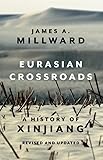Eurasian Crossroads : A History of Xinjiang, Revised and Updated / James Millward.
Material type: TextPublisher: New York, NY : Columbia University Press, [2021]Copyright date: 2021Description: 1 online resourceContent type:
TextPublisher: New York, NY : Columbia University Press, [2021]Copyright date: 2021Description: 1 online resourceContent type: - 9780231204545
- 9780231555593
- 951/.6 23
- DS793.S62 M537 2022
- DS793.S62 M537 2022
- online - DeGruyter
| Item type | Current library | Call number | URL | Status | Notes | Barcode | |
|---|---|---|---|---|---|---|---|
 eBook
eBook
|
Biblioteca "Angelicum" Pont. Univ. S.Tommaso d'Aquino Nuvola online | online - DeGruyter (Browse shelf(Opens below)) | Online access | Not for loan (Accesso limitato) | Accesso per gli utenti autorizzati / Access for authorized users | (dgr)9780231555593 |
Frontmatter -- Contents -- List of Illustrations -- List of Maps and Figures -- Preface and Acknowledgements -- Preface to the Revised and Updated Edition -- 1. Ancient Encounters (earliest times–8th century) -- 2. Central Eurasia Ascendant (9th–16th centuries) -- 3. Between Islam and China (16th–19th centuries) -- 4. Between Empire and Nation (late 19th–early 20th century) -- 5. Between China and the Soviet Union (1910s–1940s) -- 6. In the People’s Republic of China (1950s–1980s) -- 7. Between China and the World (1990s–2000s) -- 8. Colonialism, Assimilationism and Ethnocide (2000s–2020s) -- Appendix: Xinjiang Historical Timeline -- General Bibliography -- Index
restricted access online access with authorization star
http://purl.org/coar/access_right/c_16ec
Since antiquity, the vast Central Eurasian region of Xinjiang, or Eastern Turkestan, has stood at the crossroads of China, India, the Middle East, and Europe, playing a pivotal role in the social, cultural, and political histories of Asia and the world. Today, it comprises one-sixth of the territory of the People’s Republic of China and borders India, Pakistan, Afghanistan, Tajikistan, Kyrgyzstan, Kazakhstan, Russia, and Mongolia.Eurasian Crossroads is an engaging and comprehensive account of Xinjiang’s history and people from earliest times to the present day. Drawing on primary sources in several Asian and European languages, James A. Millward surveys Xinjiang’s rich environmental and cultural heritage as well as its historical and contemporary geopolitical significance. Xinjiang was once the hub of the Silk Road and the conduit through which Buddhism, Christianity, and Islam entered China. It was also a fulcrum where Sinic, steppe nomadic, Tibetan, and Islamic imperial realms engaged and struggled. In the twentieth and twenty-first centuries, the Han-dominated Chinese Communist Party has failed to include Xinjiang’s diverse indigenous Central Asian peoples. Its nationalistic visions have spurred domestic troubles that now affect the PRC’s foreign affairs and global ambitions.This revised and updated edition features new empirically grounded and balanced analysis of the latest developments in the region, focusing on the circumstances of the Uyghurs, Kazakhs, and other Xinjiang peoples in the face of policies implemented by the Chinese Communist Party.
Mode of access: Internet via World Wide Web.
In English.
Description based on online resource; title from PDF title page (publisher's Web site, viewed 26. Aug 2024)


